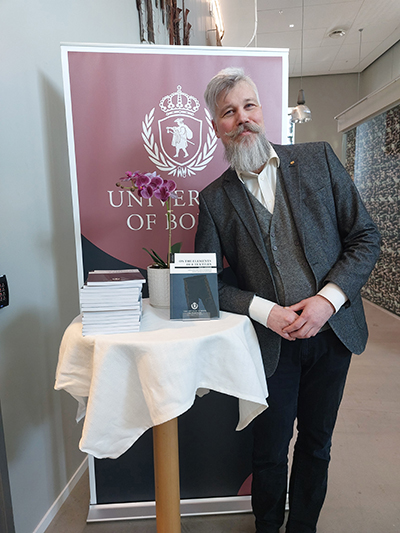Unique solution for smart textile production
2024-04-05

With an ageing population, increasing demands are being placed on healthcare and smart textiles can offer a solution where only imagination sets limits.
“The long-term goal of most smart textiles is for them to be so easy to use that the user doesn't think of them as anything more than regular garments. No special procedure should be needed to use them. If we succeed in that, we won't burden healthcare by having healthcare personnel administer vital parameter monitoring such as blood pressure and pulse, as the user can handle it themselves,” said Emanuel Gunnarsson.
"Never described before"
In his work, he has investigated how a t-shirt for measuring heart rhythm and movement patterns, and garments for electrostimulation, can be produced in a single step. This involves the connection between the contact surfaces (electrodes), the insulated conductive paths between the electrode and the contact point, and the electrical measuring equipment required.
“This, as far as we know, has never been described before. We are completely convinced that this is the solution to a significant bottleneck when it comes to getting the smart textile market going in earnest,” said Emanuel Gunnarsson.
His work has resulted in two different simple ways to produce smart textiles. He demonstrates that sensors can be integrated using standard textile manufacturing methods. The research also includes criticism of some of the methods used to measure the functionality of smart textiles, and advice on how to do it better instead.
 Will you continue your work?
Will you continue your work?
“Yes, the next natural step will be to see how these garments cope with one of the toughest challenges a garment faces, namely washing. Especially as these garments must be worn closest to the skin, they will need to be washed relatively often,” said Emanuel Gunnarsson.
Studies from other universities indicate that the yarns used to measure signals from the body do not withstand many washes, but after a small pilot study, Emanuel Gunnarsson is hopeful of the opposite.
“I've had the privilege of having one of our very talented, ambitious, and enthusiastic textile engineering students willing to help me with this as part of their thesis. I hope we can use the results for a future peer-reviewed publication on the subject. In the longer term, we also need to conduct larger field studies to confirm the robustness of the garments. We have already conducted some field studies, but I would like to do even larger ones.”
He described how the work he has done would never have been possible without the incredibly skilled technicians in the labs of the Swedish School of Textiles and the equipment they master.
“I cannot stress this enough, and I am extremely grateful to all those who have helped finance our machinery over the years and for the school's recognition of the importance of having that expertise n-site. In Borås, we have the immense advantage of being equipped with very fine laboratory environments.”
How has your time as a doctoral student been?
“My time as a doctoral student has been like a rollercoaster. Most of my colleagues report the same thing. Sometimes everything runs smoothly, and sometimes the track is full of obstacles. Other times it’s completely broken, and you have to back up and take a different route. It’s an incredibly educational time and a hugely rewarding, but it comes with high demands. I cannot emphasise enough that as a doctoral student, you have a well-functioning team of supervisors, examiners, and director of studies around you. In my case, I have been fortunate to have had all these roles filled by people who really knew their stuff, showed confidence in me, and had their hearts in the right place.”
Emanuel Gunnarsson defended his thesis on 18 March with the thesis titled On the Elements of E-Textiles: The Fabrication and Characterisation of Textile Routing and Electrodes
The external examiner was Professor Vladan Koncar, University of Lille/ENSAIT.
Grading committee:
Associate Professor, Paolo Bonato, Harvard Medical School
Professor, Jukka Vanhala, Tampere University
Dr Daniela Zavec, ITP GmbH Gesellschaft für Intelligente Textile Produkte
Principal supervisor: Professor Fernando Seoane Martinez, University of Borås
Read more
Lina Färm Translation by Eva Medin
Detail (trousers): Emanuel Gunnarsson Portraits: Lina Färm (top photo), May Kahoush

